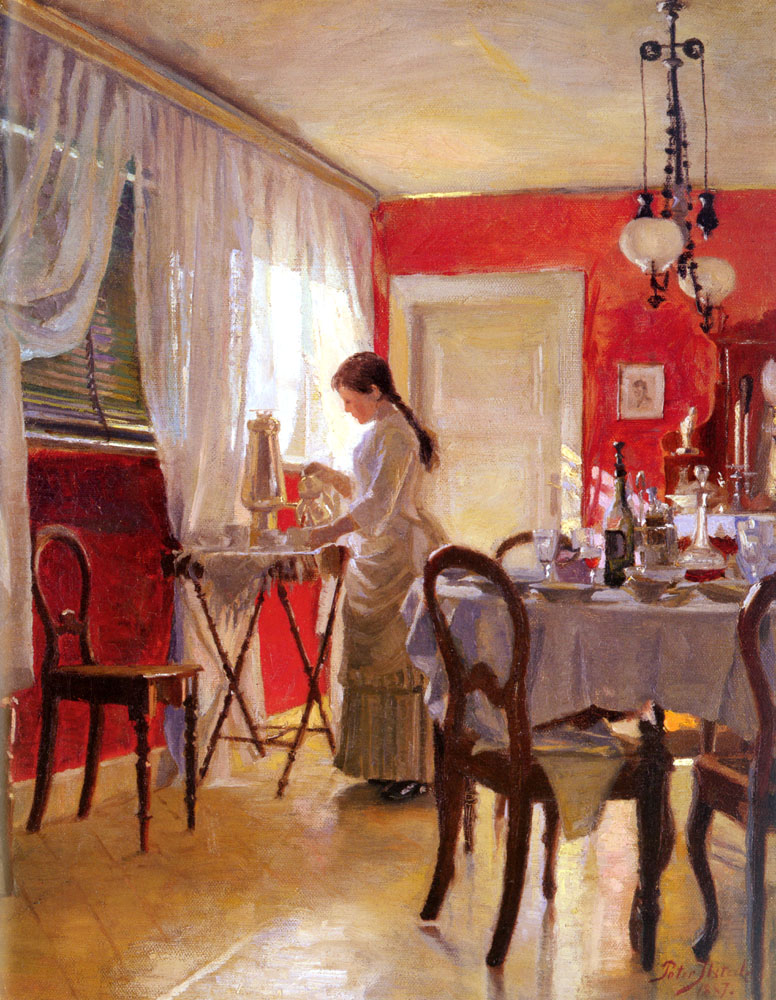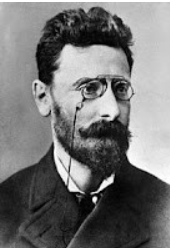The Industrial Revolution changed the world in many ways. It brought capitalism and consumerism into being, changing the world’s outlook on wealth creation. It revolutionized technology, allowing the innovation of mass production to expand exponentially. Jobs in factories shifted labor from farming to factories. With this came the migration of people from countrysides into cities as the economy shifted from an agrarian society into an industrialized society. This shift altered the social structure of the family. Beginning in the early nineteenth century, as the effects of the Industrial Revolution began to settle, a pattern became visible. With the rise of industrial labor, men transformed their function from director of work to provider of income, developing their role in the public sphere as laborers and professionals. Meanwhile, women took on the role of educating the children and keeping the home in order, forming the private sphere within the household.1
Historians argue over how we should understand these separate spheres. Some argue that working-class women had to participate in the public sphere out of necessity for earning a living, and therefore they were denied the choice of participating in the cult of domesticity.2 They argue that although these women’s position in society was marginal, they created an identity for themselves in the public sphere.3 While these historians claim that participation in the cult of domesticity was restricted to middle-class women, I argue that working-class women, when they had the choice, often chose to work in the private sphere, thereby choosing to participate in the cult of domesticity to the best of their abilities.

As the Industrial Revolution changed the mold of society, the public sector and the private home became two isolated and separate worlds. The private sphere of influence that women were associated with in the nineteenth century refers to the realm in which a woman’s role was as the head of the domestic household. In contrast, men participated in the public sphere, which included the worlds of labor, politics, and association.4 In her role in the private sphere, a woman determined the social reproduction aspect of the family, as opposed to the economic production. Social reproduction is defined by feminists as the labor involved in the maintenance of a lifestyle as well as producing the next generation.5 This work goes beyond bearing children, including activities such as making food, clothing, and shelter immediately available; teaching and caring for children; caring for the elderly; and providing a good moral example within her home.6 From an early age, girls’ education centered around making good wives and mothers with programs that guaranteed gentility and femininity. By participating in such activities, women helped to form the organization of society through their families. While the class of their families contributed to the flexibility of their appearance in the public sphere, there is a clear distinction between public and private worlds.
The newly formed middle class of the nineteenth century is the most overwhelming indication of the separation of spheres. With industrialization on the rise, clear gender roles emerged as the social structure of the family changed.7 Whereas in the working class both women and men contributed to the family income, in middle-class families the men worked for wages while their wives stayed home to manage the household.8 This gave women of the middle class little opportunity to participate in the public sphere. A clear indicator of middle-class status was the ability to keep any number of servants. Most families had only one servant.9 Nevertheless, it was the women of the household that directed their work in their homes. This was the contribution they made to their household. The occupation of homemaker, though valuable to the family, cemented their lives in the private sphere. Mothers were expected to provide for the education of their children. It was because of this ideology that middle-class women were able to be educated in math, literature, history, and foreign language, and to teach their children in turn.10 As daughters grew up, the limited education they received was the basis for wives and mothers to properly fulfill their roles, teaching their children as the cycle of domesticity repeated itself.

Due to their economic need to work, working-class women had more of an opportunity to be in the public sphere. In order to survive, these women, as laborers, interacted with employers, landlords, police, and other public institutions such as schools.11 This blurred the line between the private and public spheres. It was for this reason that working-class women were seen as hostile and aggressive. Although they did have interactions in the public sphere, this conflicted with their assigned role as caretakers. In order to do what was necessary to provide for their families, they were perceived as risking their moral virtue by entering the public sphere. With this morality at stake, it was easy for society to question these women’s ability to care for a household when the private and public spheres were viewed as being so isolated from each other. Thus, being employed in a factory, or another public institution was viewed as unfavorable to working-class families seeking jobs for their daughters. These daughters were to grow to become the wives and mothers of the next generation, so they needed to be viewed with the capability to support domesticity. Therefore, when women had the choice, these young women often chose to be employed as a servant, which was a less humiliating alternative to factory work.12
These young, working-class women helped their families by earning income while remaining in the private sphere. Their class status remained distinctly working class, as it was the distinction to hire a servant in the first place that separated the middle class from the working class. But even when a working-class daughter or wife needed to contribute to the family’s income, if she chose to work as a domestic servant, her could remain largely in the private sphere, although in the private sphere of another woman’s home. An 1891 study shows that out of the 772 domestic servants working in Lancaster, only eight were men.13 Clearly there is an overwhelming difference in number of female servants as opposed to male domestics. Thus, by the Victorian standards that fostered the separate spheres sensibilities, these working-class women were subsequently choosing to remain in the private realm. The same study shows that the majority of servants were young single women. This indicates that these women were preparing for their lives as wives and mothers by supporting their father’s household through work in a private home.14 It further shows that young women worked in factories and entered the public sphere only when absolutely necessary.

Through the examinations of the work that women of the lower and middle classes contributed to their families, there is a clear distinction that emerged in contrast to their husbands and fathers. While middle-class women dedicated their lives to their work in the privacy of their homes, working-class women were required to roam the male-dominated public sphere by working. Still, a clear distinction emerges, as working women often chose jobs in the homes of the wealthier classes. Through this evidence, I have argued that women most often sought to remain in the private sphere, either as middle-class women or as working-class servants, while their husbands and fathers worked to provide for their families economically. Therefore, despite the claim that participation in the restrictions of the private sphere pertained only to the middle class, it is clear that working-class women often chose to work in the private sphere rather than in the public eye.
- Barbara Laslett and Johanna Brenner, “Gender and Social Reproduction,” Annual Review of Sociology, vol. 15 (1989): 387. ↵
- Amanda Vickery, “Golden Age to Separate Spheres? A Review of the Categories and Chronology of English Women’s History,” The Historical Journal, vol. 36, no. 2 (June 1993): 389. ↵
- Ruth L. Smith and Deborah M. Valenze, “Mutuality and Marginality: Liberal Moral Theory and Working Class Women in Nineteenth Century England,” Signs, vol. 13, no. 2 (winter 1988): 278. ↵
- Ellen Jordan, “‘Making Good Wives and Mothers’? The Transformation of Middle-Class Girls’ Education in Nineteenth-Century Britain,” History of Education Quarterly, vol. 31, no. 4 (Winter 1991): 443. ↵
- Barbara Laslett and Johanna Brenner, “Gender and Social Reproduction,” Annual Review of Sociology, vol. 15 (1989): 385. ↵
- Ellen Jordan, “‘Making Good Wives and Mothers’? The Transformation of Middle-Class Girls’ Education in Nineteenth-Century Britain,” History of Education Quarterly, vol. 31, no. 4 (Winter 1991): 442. ↵
- World History Encyclopedia, 2011, s.v. “The Cult of Domesticity in the United States and Britain.” ↵
- Barbara Laslett and Johanna Brenner, “Gender and Social Reproduction,” Annual Review of Sociology, vol. 15 (1989): 389. ↵
- Siân Pooley, “Domestic Servants and Their Urban Employers: A Case Study of Lancaster, 1880-1914,” The Economic History Review, New Series, vol. 62, no. 2 (May 2009): 407. ↵
- Ellen Jordan, “‘Making Good Wives and Mothers’? The Transformation of Middle-Class Girls’ Education in Nineteenth-Century Britain,” History of Education Quarterly, vol. 31, no. 4 (Winter 1991): 442. ↵
- Ruth L. Smith and Deborah M. Valenze, “Mutuality and Marginality: Liberal Moral Theory and Working Class Women in Nineteenth Century England,” Signs, vol. 13, no. 2 (winter 1988): 286. ↵
- Siân Pooley, “Domestic Servants and Their Urban Employers: A Case Study of Lancaster, 1880-1914,” The Economic History Review, New Series, vol. 62, no. 2 (May 2009): 418 ↵
- Siân Pooley, “Domestic Servants and Their Urban Employers: A Case Study of Lancaster, 1880-1914,” The Economic History Review, New Series, vol. 62, no. 2 (May 2009): 411. ↵
- Siân Pooley, “Domestic Servants and Their Urban Employers: A Case Study of Lancaster, 1880-1914,” The Economic History Review, New Series, vol. 62, no. 2 (May 2009): 411. ↵



63 comments
Kristen Leary
Great article! I first of all have to comment on your use of images. Each image seemed well thought out and really added to your article in a positive way. I really enjoyed reading this article! It often feels as though we are told women lived dull, meaningful and repressed lives before it was common for them to work outside of the home. This article does a good job at explaining how society functioned at the time and that men and women largely ran in two separate spheres, one public and one private. Women had many roles, responsibilities, and even jobs within the private sphere before a time it became common and acceptable to work more so in the public sphere alongside men. Very interesting read.
Alejandro Fernandez
In this article, the author discusses the Industrial Revolution and its overall affect on various parts of society. Specifically, I was unaware of how the Industrial Revolution played a role in gender roles and continued to shape today’s culture. Ultimately, it’s important to acknowledge how this era played a role in working class women and their desire to achieve more.
Noelia Torres Guillen
I really liked this article because it taught me more about the industrial revolution and the influence it had in society. There was a huge shift which allowed women to engage and participate in the public sphere instead of just staying at home in the private sphere. Women had to work twice as hard, it seemed like they were never given a break. You had to be more cautious about your public appearance in order to get a good job to help with your current and future family. great work!
Peter Alva
I like this article because it’s informative on how gender roles were molded into society. I like the way of describing it as a “Private sphere” which is something I never heard of before while bringing up working. I also like how it talks about levels of income in the article and how their home life was. Its interesting knowing what life was like for women in a lower income household being that them staying at home was their job at this time.
Melyna Martinez
This article I believe does well at showing how much gender roles and stereotypes affect women in society. In return the article allows us to see that are evolvent as a society had happen but there is still much that needs to change in regards to women’s values. As it is interesting that one of the main reason women started to get an education is that they were raising children.
Christopher Morales
This article was written very well. I felt like I was engaged throughout the whole article. It is an interesting topic that we still discuss in today’s society. The middle class being the strength and structures of the household became very prevalent in this time that your article describes. As we strive for more equality, it is important to remember the creation and history of how gender roles came into place. You did a great job separating and explaining the distinct split that created division for the lower class. It is interesting to see how these ideas and concepts relate to issues we are fighting today.
Martina Flores Guillen
Not only did the industrial revolution affect the lives of many working-class families but mainly women’s lives and their roles. Women are seen to be equally affected by the industrial revolution and its high demand for women’s house roles in their house roles. Women, in particular, were expected to utilize their skills to divide themselves into more than homemakers but house leads that would support more than just their families.
Marie Peterson
This was a very interesting article to read. It is interesting to see how the need for more income contributed to the equality of women. As well, as how this beginning to equality still plays a role in today’s society. Women continue to work at a higher rate in jobs that would be considered the private sphere. While women work in different jobs this aspect of history continues to affect the present in a way. Great job!
Sydney Nieto
This was a great and interesting article. The fact that women would have to teach their kids everything, such as education and manners is crazy. I also found it interesting how out of 772 domestic servants only eight were men. It did make sense that women would want to work as servants rather than factories. Overall, good job on the article.
Jose Maria Gallegos Cebreros
I really enjoyed reading your article, it helped me understand a topic that i did not know about before and it was very informative. I think the images you used on your article match perfectly with the content and they give the reader a lot of information besides the text. I found the content very interesting and I think it is a topic that not a lot of people knows about and it is so interesting.